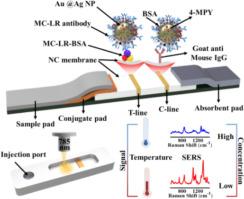Synchronized SERS-temperature dual signals generated from the same incident light for Immunochromatography assay of microcystin LR in aquatic products
IF 4.9
2区 化学
Q1 CHEMISTRY, ANALYTICAL
引用次数: 0
Abstract
Dual-signal cross-validation enhances the reliability of quantitative measurements. However, asynchronous dual signals generated from different incident light affect the acquisition time and reliability of quantitative detection. In this work, we proposed an immunochromatography (ICA) sensor that utilizes synchronized Surface-Enhanced Raman Scattering (SERS) and temperature dual signals generated from the same incident light for analyzing microcystin-LR (MC-LR) in aquatic products. Quantitative analysis reveals a good linear correlation between the dual signals and the logarithmic concentration of MC-LR over the range of 0.001000–80.00 ng/mL. Moreover, the proposed method demonstrated excellent recovery rates and the results were similar with enzyme-linked immunosorbent assay, but the signal acquisition time (3 s) and overall detection time (10 mins) of our approach were significantly reduced. Therefore, a synchronized dual signals ICA sensor that combines SERS and photothermal technology was constructed for direct, rapid, and reliable detection of MC-LR, providing a promising application for field-based monitoring.

同一入射光产生同步sers -温度双信号用于水产品中微囊藻毒素LR的免疫层析分析
双信号交叉验证提高了定量测量的可靠性。然而,不同入射光产生的异步双信号影响了定量检测的采集时间和可靠性。在这项工作中,我们提出了一种免疫层析(ICA)传感器,该传感器利用同一入射光产生的同步表面增强拉曼散射(SERS)和温度双信号来分析水产品中的微囊藻毒素lr (MC-LR)。定量分析表明,双信号与MC-LR的对数浓度在0.001000 ~ 80.00 ng/mL范围内呈良好的线性相关。此外,该方法具有良好的回收率,结果与酶联免疫吸附法相似,但我们的方法的信号采集时间(3 s)和总检测时间(10 min)显着缩短。因此,构建了一种结合SERS和光热技术的同步双信号ICA传感器,可直接、快速、可靠地检测MC-LR,为现场监测提供了广阔的应用前景。
本文章由计算机程序翻译,如有差异,请以英文原文为准。
求助全文
约1分钟内获得全文
求助全文
来源期刊

Microchemical Journal
化学-分析化学
CiteScore
8.70
自引率
8.30%
发文量
1131
审稿时长
1.9 months
期刊介绍:
The Microchemical Journal is a peer reviewed journal devoted to all aspects and phases of analytical chemistry and chemical analysis. The Microchemical Journal publishes articles which are at the forefront of modern analytical chemistry and cover innovations in the techniques to the finest possible limits. This includes fundamental aspects, instrumentation, new developments, innovative and novel methods and applications including environmental and clinical field.
Traditional classical analytical methods such as spectrophotometry and titrimetry as well as established instrumentation methods such as flame and graphite furnace atomic absorption spectrometry, gas chromatography, and modified glassy or carbon electrode electrochemical methods will be considered, provided they show significant improvements and novelty compared to the established methods.
 求助内容:
求助内容: 应助结果提醒方式:
应助结果提醒方式:


